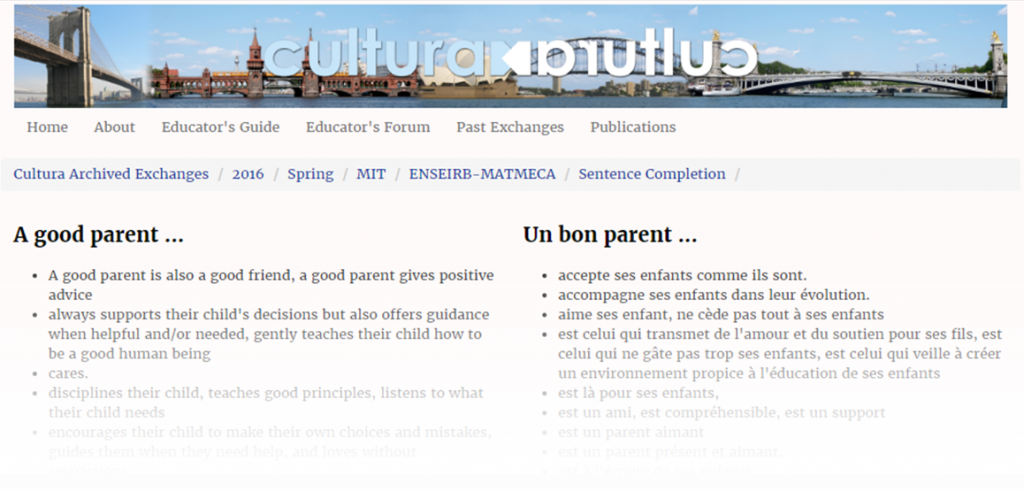Cultura is an intercultural project that connects groups of students online to help them understand each other’s cultures. This activity allows students to compare their own culture with the target culture using existing online exchanges, and to reflect upon themselves as intercultural speakers.
Learning outcomes
Following this activity you will:
- become aware of the values, attitudes, beliefs, and concepts inherent in another culture;
- understand the concept and importance of becoming an intercultural speaker;
- practice reading text in your target language
- gain an understanding of cultural and intercultural competence in your target language
Learning context
This activity could be carried out prior to and following your Mobility Programme.
Procedure
- Visit the Cultura Project Webpage to begin the activity.
Note: There is no requirement to set up an account to view the archived discussions.
Image courtesy of Cultura Project - Click on the ‘past exchanges’ section on the menu bar.
- Access the archived exchanges by clicking on ‘Answers & Discussion’ for the topic of your choice.
- There are three distinct types of exchanges; word association, sentence completion, and reactions to a situation.
- Choose a topic of interest and read through the responses from both exchange groups.

Image courtesy of Cultura Project - Reflect on the responses and the entries in the comments section.
- What cultural aspects were discussed in this particular interaction?
- What did you learn?
- Were you surprised by any comment?
- What do you understand by the term ‘intercultural speaker’?
- Search for the term ‘intercultural speaker’ (learn more about Search Literacy).
- Reflect on the characteristics you feel an intercultural speaker needs to have.
- Why is it important to have these skills when travelling on your Mobility Programme.
Suggested extension to this activity
Create a poster in your target language using padlet, mindmup (or similar tool of your choice). List the characteristics an intercultural speaker should have, using your own research as a reference.
Reflect upon this list following the Mobility Programme and compare the differences and stereotypes of the target language culture.
Source/attribution: DigiLanguages Author: Marta Giralt
<a href=”http://cultura.mit.edu/what-is-cultura” target=”_blank” rel=”noopener noreferrer” data-mce-href=”http://cultura.mit.edu/what-is-cultura”>Cultura</a> is an intercultural project that connects groups of students online to help them understand each other’s cultures. This activity allows students to compare their own culture with the target culture using existing online exchanges, and to reflect upon themselves as intercultural speakers.<strong>Learning outcomes</strong>Following this activity you will:<li>become aware of the values, attitudes, beliefs, and concepts inherent in another culture;</li><li>understand the concept and importance of becoming an intercultural speaker;</li><li>practice reading text in your target language</li><li>gain an understanding of cultural and intercultural competence in your target language</li>
<strong>Learning context</strong>This activity could be carried out prior to and following your Mobility Programme.<br /><strong>Procedure</strong><li>Visit the <a href=”http://cultura.mit.edu/” target=”_blank” rel=”noopener noreferrer” data-mce-href=”http://cultura.mit.edu/”>Cultura Project</a> Webpage to begin the activity.<br />
<strong>Note: </strong>There is no requirement to set up an account to view the archived discussions.<p><br /></p><div class=”mceTemp”><dl id=”attachment_2942″ class=”wp-caption aligncenter” style=”width: 724px;” data-mce-style=”width: 724px;”><dt class=”wp-caption-dt”><img class=”wp-image-2942 ” src=”https://www.digilanguages.ie/wp-content/uploads/2016/11/Cultura-Screenshot-menu-bar-1024×160.png” alt=”Image courtesy of Cultura” width=”724″ height=”113″ data-mce-src=”https://www.digilanguages.ie/wp-content/uploads/2016/11/Cultura-Screenshot-menu-bar-1024×160.png” /></dt><dd class=”wp-caption-dd”><em>Image courtesy of <a href=”http://cultura.mit.edu/” target=”_blank” rel=”noopener noreferrer” data-mce-href=”http://cultura.mit.edu/”>Cultura Project</a></em></dd></dl></div></li><li>Click on the ‘past exchanges’ section on the menu bar.</li><li>Access the archived exchanges by clicking on ‘Answers & Discussion’ for the topic of your choice.</li><li>There are three distinct types of exchanges; word association, sentence completion, and reactions to a situation.</li><li>Choose a topic of interest and read through the responses from both exchange groups.<div class=”mceTemp”><dl id=”attachment_2946″ class=”wp-caption aligncenter” style=”width: 679px;” data-mce-style=”width: 679px;”><dt class=”wp-caption-dt”><img class=” wp-image-2946″ src=”https://www.digilanguages.ie/wp-content/uploads/2016/12/Cultura-Screenshot-Exchange-sample-1024×491.png” alt=”Image courtesy of Cultura Project” width=”679″ height=”326″ data-mce-src=”https://www.digilanguages.ie/wp-content/uploads/2016/12/Cultura-Screenshot-Exchange-sample-1024×491.png” /></dt><dd class=”wp-caption-dd”><em>Image courtesy of <a href=”http://cultura.mit.edu/” target=”_blank” rel=”noopener noreferrer” data-mce-href=”http://cultura.mit.edu/”>Cultura Project</a></em></dd></dl></div></li><li>Reflect on the responses and the entries in the comments section.<ul><li>What cultural aspects were discussed in this particular interaction?</li><li>What did you learn?</li><li>Were you surprised by any comment?</li><li>What do you understand by the term ‘<a href=”http://languageeducation.pbworks.com/w/page/47700811/Intercultural%20Speakers” target=”_blank” rel=”noopener noreferrer” data-mce-href=”http://languageeducation.pbworks.com/w/page/47700811/Intercultural%20Speakers”>intercultural speaker'</a>?</li>
</ul>
</li><li>Search for the term ‘<a href=”http://languageeducation.pbworks.com/w/page/47700811/Intercultural%20Speakers” target=”_blank” rel=”noopener noreferrer” data-mce-href=”http://languageeducation.pbworks.com/w/page/47700811/Intercultural%20Speakers”>intercultural speaker'</a> (learn more about <a href=”/search-literacy-what-is-it-2/?role=9&subCategory=32&workPackage=21″ target=”_blank” rel=”noopener noreferrer” data-mce-href=”/search-literacy-what-is-it-2/?role=9&subCategory=32&workPackage=21″>Search Literacy</a>).</li><li>Reflect on the characteristics you feel an intercultural speaker needs to have.</li><li>Why is it important to have these skills when travelling on your <a href=”/pre-mobility-programme/?role=11&subCategory=75&workPackage=70″ target=”_blank” rel=”noopener noreferrer” data-mce-href=”/pre-mobility-programme/?role=11&subCategory=75&workPackage=70″>Mobility Programme.</a></li>
<br /><strong>Suggested extension to this activity</strong>Create a poster in your target language using <a href=”https://es.padlet.com/” data-mce-href=”https://es.padlet.com/”>padlet</a>, <a href=”https://www.mindmup.com/” target=”_blank” rel=”noopener noreferrer” data-mce-href=”https://www.mindmup.com/”>mindmup </a>(or similar tool of your choice). List the characteristics an intercultural speaker should have, using your own research as a reference.Reflect upon this list following the Mobility Programme and compare the differences and stereotypes of the target language culture.<strong>Source/attribution:</strong> DigiLanguages <strong>Author: </strong>Marta Giralt

